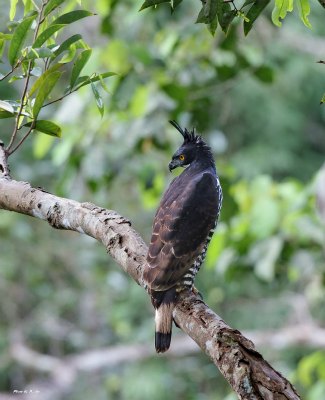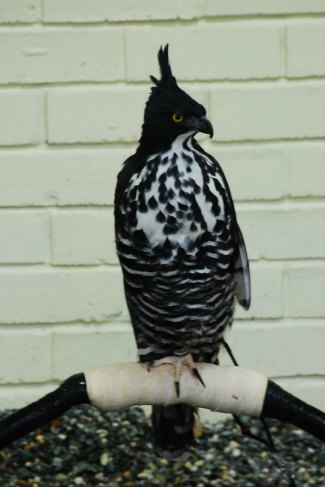Blyth's Hawk Eagle - Nisaetus alboniger
By Hiyashi Haka, CC-BY-NC-SA-2.0, via Flickr
Family: Accipitridae
Genus: Nisaetus
Species: N. alboniger
Blyth's Hawk Eagles are black, medium-sized eagles that live in and around the Malay peninsula. They form a clade with Nisaetus bartelsi (Javan Hawk Eagle), N. kelaarti (Legge's Hawk Eagle), N. nanus (Wallace’s Hawk Eagle), and N. nipalensis (Mountain Hawk Eagle). They are also a sister species to N. nipalensis.
Physical Description:
Blyth’s Hawk Eagles are all black from above. The belly and underparts are white barred with black, and the legs are long and feathered. They have a black head, crest, and beak, and bright yellow eyes. There are thick white bands on the undertail and the uppertail.
Juveniles are dark brown, with a lighter brown head and underparts. They reach full adult plumage by the third or fourth year.
Blyth's Hawk Eagle calls are sharp, high-pitched whistling sounds. Listen to a recording.
Size:
Length: 51-58 cm
Wingspan: 56-70 cm
Weight: 830 g
Habitat and Distribution:
They live in tropical areas where there is montane and hilly forest, from 200-1700 meters above sea level. Island-dwelling birds prefer denser forest.
They are found throughout the Malay Peninsula, Sumatra, and Sabah, 11°N to 6°S, across a range of over 900,000 km². There are approximately 1,000 individuals.
By Su Chen, CC-BY-SA-3.0, via Wikimedia Commons
Diet and Hunting:
Blyth’s Hawk Eagles eat small mammals, birds, lizards, and bats. They hunt in the air, foraging by circling over the tree canopy, but have also been recorded taking poultry from the ground.
Reproduction:
The nest is deep and cup-shaped and usually set in a tree higher than the rest of the canopy. Clutch size is one egg. Leafy branches are taken to the nest throughout the nesting period, until the chick fledges. Fledging takes no longer than four months, though the exact time is unknown.
Conservation:
The population is decreasing due to slash and burn agriculture and deforestation, but the decline is not greater than 30% over ten years or three generations, which is the threshold for Vulnerable status. The bird is currently listed as Least Concern by BirdLife International.
Taxonomy:
Genus Nisaetus used to be considered part of Spizaetus, but the sequencing of one intron and mitochondrial genes showed that Asian hawk eagles (Nisaetus) are part of a different lineage than New World hawk eagles (Spizaetus), and the two were therefore split. Nisaetus alboniger forms a clade with N. bartelsi (Javan Hawk Eagle), N. kelaarti (Legge's Hawk Eagle), N. nanus (Wallace’s Hawk Eagle), and N. nipalensis (Mountain Hawk Eagle). In addition, N. nipalensis and N. alboniger were found to be sister species.
Other Names:
Orel pralesní (Czech), Sorthovedet Høgeørn (Danish), Blyth-kuifarend (Dutch), Malai tuttkotkas (Estonian), Vuorijalokotka (Finnish), Aigle de Blyth (French), Traueradler (German), Spizaeto di Blyth (Italian), Kaogurokumataka (Japanese), Helang Hindek Gunung (Malay), Malayskogørn (Norwegian), Wojownik zalobny (Polish), Águila Azor de Indonesia (Spanish), Blyths hökörn (Swedish).
Video of a Blyth's Hawk Eagle:
References:
http://avibase.bsc-eoc.org/species.jsp?avibaseid=76745280F7A71AE4
BirdLife International (2011) Species factsheet: Nisaetus alboniger. Downloaded from http://www.birdlife.org on
15/10/2011.
Global Raptor Information Network. 2011. Species account: Blyth's Hawk-eagle Nisaetus alboniger. Downloaded from
http://www.globalraptors.org on 15 Oct. 2011
BirdLife International 2009. Nisaetus alboniger. In: IUCN 2011. IUCN Red List of Threatened Species. Version 2011.1.
www.iucnredlist.org. Downloaded on 15 October 2011.
http://www.planetofbirds.com/accipitriformes-accipitridae-blyths-hawk-eagle-nisaetus-alboniger
Ferguson-Lees, James, and Christie, David A. Raptors of the World. Houghton Mifflin Company, 2001.

